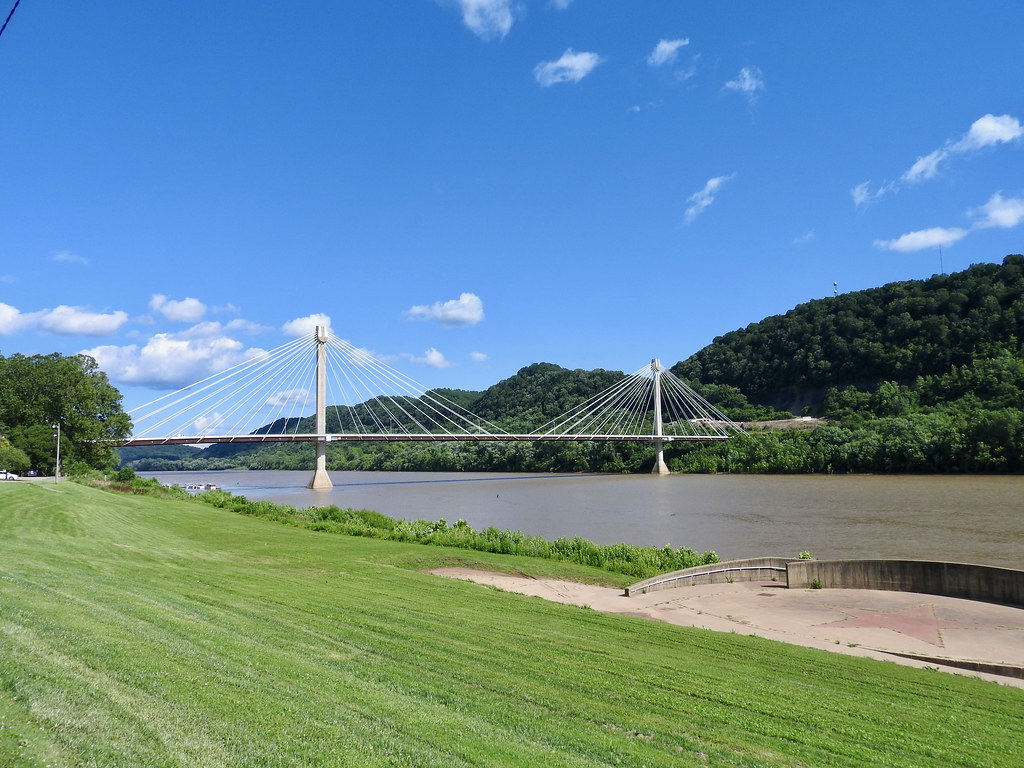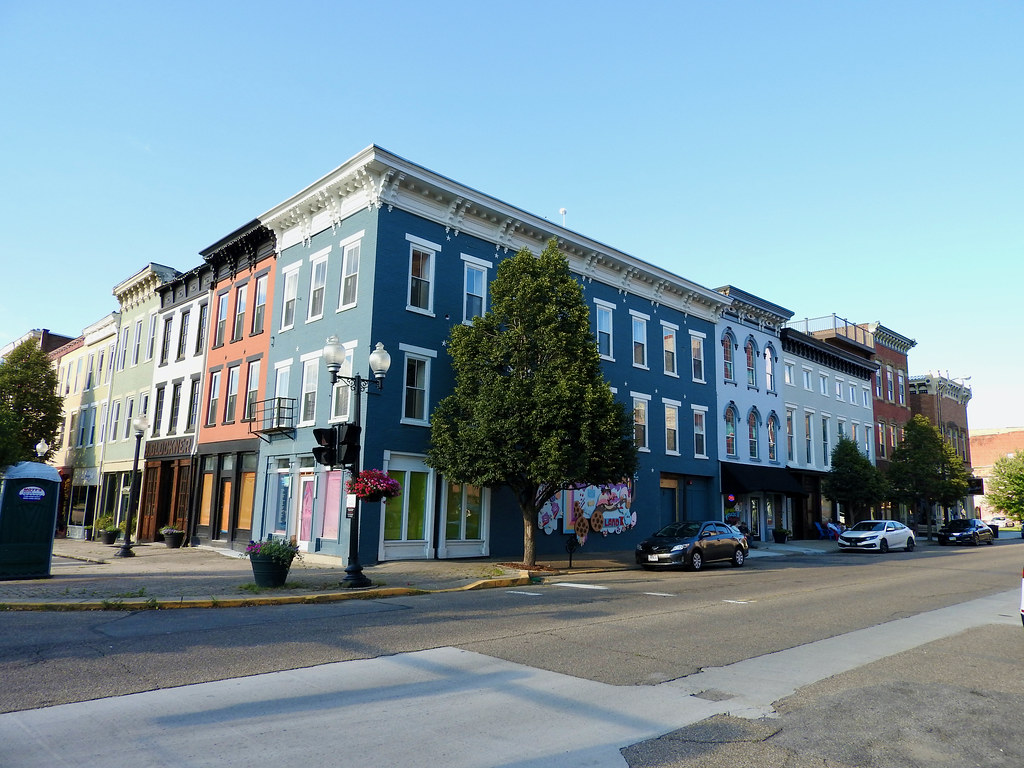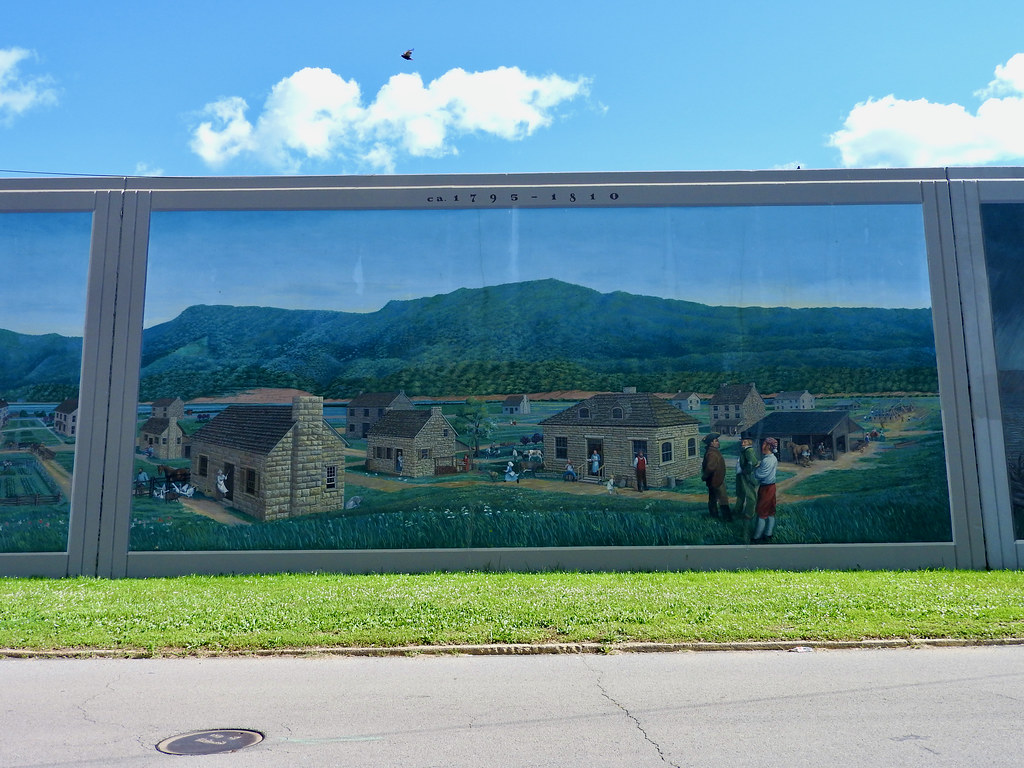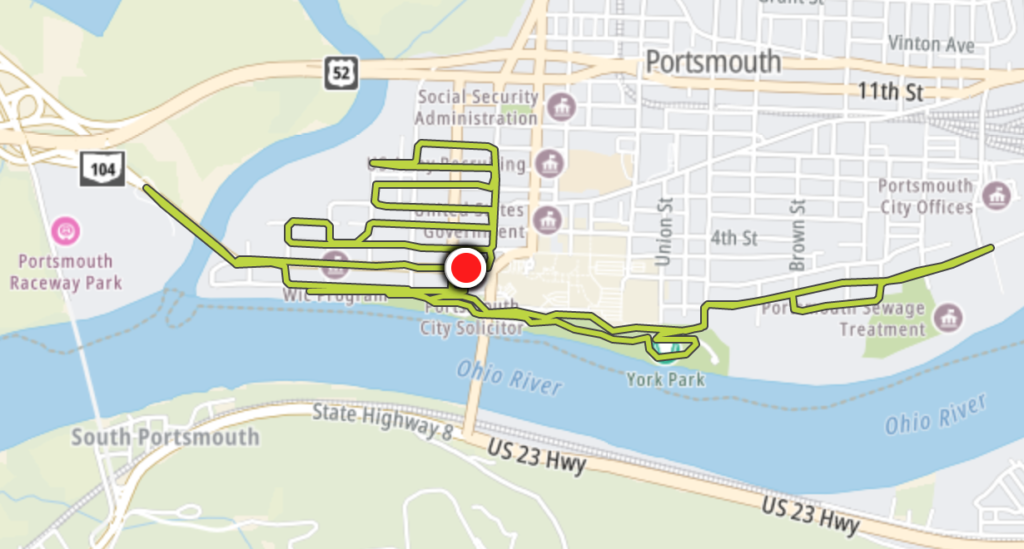We began our journey with an easy drive along Interstate highways. I worried a bit about I-81 and its abundant truck traffic on the Friday before a 3-day weekend. Nonetheless we made it through and shot across West Virginia on I-64 unscathed. From there we only had to cut away at Huntington and follow the Ohio River downstream to Portsmouth, Ohio (route). I’d never been to Portsmouth before. In fact I’d never even heard of the place before the trip.
A Little Context

We entered Portsmouth on the U.S. Grant Bridge, a modern cable-stayed structure built in 2006. Then we stopped overnight, positioning ourselves for some serious county-counting the following morning.
Portsmouth sat at the confluence of the Ohio and Scioto Rivers, a natural place for people to settle. So that’s exactly what happened. Americans of European descent arrived in significant numbers in the 1790’s, displacing the native population. Portsmouth thrived at the dawn of Industrialization. The river served as a highway and railways did the same a few decades later. Then iron and steel factories arrived, followed by a healthy diversification into many other industries: shoes; furniture; bricks and more.
It looked like Portsmouth might grow into a major city during the first part of the Twentieth Century. The population climbed all the way to 42,000 in the 1930 Census. Then it slowly fell apart, a victim of the same trends that harmed so many other Rust Belt cities. Good-paying manufacturing jobs moved overseas and people left the area for better opportunities. Those who stayed behind couldn’t maintain the same standard of living with what remained.
Portsmouth lost population in every single Census after 1930 and fell to 20,000 people most recently. There was one small silver lining to the story, though. At least the hemorrhaging slowed down in the last couple of decades.
Turning a Corner

I could see signs of that decline in empty lots and the many buildings that needed substantial maintenance. But I also observed signs of resurgence, like shoots of grass poking through after a wildfire. People were plowing money into century-old commercial buildings along 2nd Street. Those held antique stores, restaurants, condos and all manner of specialty shops. Vintage commercial buildings featured wonderful architectural details and shined in their restored glory.
So the people in Portsmouth pushed hard to reinvent. Manufacturing jobs will never return and they understood that. They obviously had a lot of pride in their town and the potential clearly showed. Sure, we saw a few residents who carried the stereotypical signs of opioid addiction (a big problem in this area of the country) but the town itself seemed to be trying to move beyond that.
Flood Stories

A huge concrete wall separated Portsmouth from the Ohio River. It served as a barrier protecting the city from floods, a common feature of settlements along the river. Additonally, they did something a little different here along Front Street. They turned an otherwise ugly wall into a beautification project.
Portsmouth hired Robert Dafford of Lafayette, Louisiana to paint 2,000 feet of blank wall. It took him and his assistants more than a decade and the effort extended to sixty mural panels. The trompe-l’œil styling told a linear story, stretching through two centuries of local history. It reminded me of a similar painted wall in Cape Girardeau, Missouri, although much longer and more realistic.
Boneyfiddle

We didn’t have to drive all that far the second day and we couldn’t check into our home until mid-afternoon anyway. That left us with plenty of time to dawdle in Portsmouth for most of the morning. So I stepped outside of our hotel and went for a ten-mile run on a blessedly comfortable Saturday morning. I went out-and-back along the river, passed the flood wall murals for another peek, and zig-zagged through streets near the river confluence.
The neighborhood where I covered all of the streets had an odd name: Boneyfiddle. Nobody really knew why. Germans settled the area initially so it might have come from something mangled into English. Others speculated that discarded bones from some long ago slaughterhouse might have been the source. Either way, I enjoyed the banner with a skeleton playing a violin that hung from some of the area lampposts.
Once it existed as a distinct settlement standing on its own. Then Portsmouth grew and subsumed it. But Boneyfiddle didn’t disappear, it became the commercial hub of the city during its era of prosperity. Then it became the hub of decay during its decline. It seemed to be improving along with the rest of the city although it still had a ways to go. I never felt uncomfortable running through it, though.
Dinnertime

We enjoyed dinner at Portsmouth Brewing Company on that first evening of our journey. It must be difficult to succeed as a brewery in an area essentially bereft of them. Even so they’ve been in business since 1997 so clearly they’ve figured something out. I’m guessing it’s because they embraced the sale of mainstream beverages alongside their own. We sat at an outdoor patio where most groups ordered Bud Light or similar to share by the six-pack, delivered in ice buckets.
In spite of being physically in Ohio, the area seemed more like Kentucky. It felt downright Appalachian (and I say that in the most loving, appreciative way). Folks seemed to have a hint of a drawl in their accent. I spied a surprising number of Confederate flags. Pickup trucks outnumbered sedans. 90% of the population identified as White in the 2010 Census. So it drove home how Ohio functions a swing state in national elections.
Everyone knew everyone else on the patio as they kicked-off their 4th of July weekend. And the band started cranking Southern Rock. We shared the patio with a ton of bikers, not so much a “gang” per se; more like middle-aged dudes on Harleys. They seemed harmless. Everyone just wanted a good time. But I was also perfectly happy to keep a social distance with the the super-contagious Delta variant of COVID on the rise as our journey began. I got the sneaking suspicion that vaccine rates here probably wouldn’t blunt it.
Articles in the Ohio River Series
- Orientation
- Portsmouth
- Onward Towards Louisville
- Exploring Louisville
- Brewery Cluster
- The Big Four
- Corydon Loop
- Ark Loop
- Evansville Loop
- Heading Back Upstream
- Marietta
See Also: The Complete Photo Album on Flickr

Leave a Reply